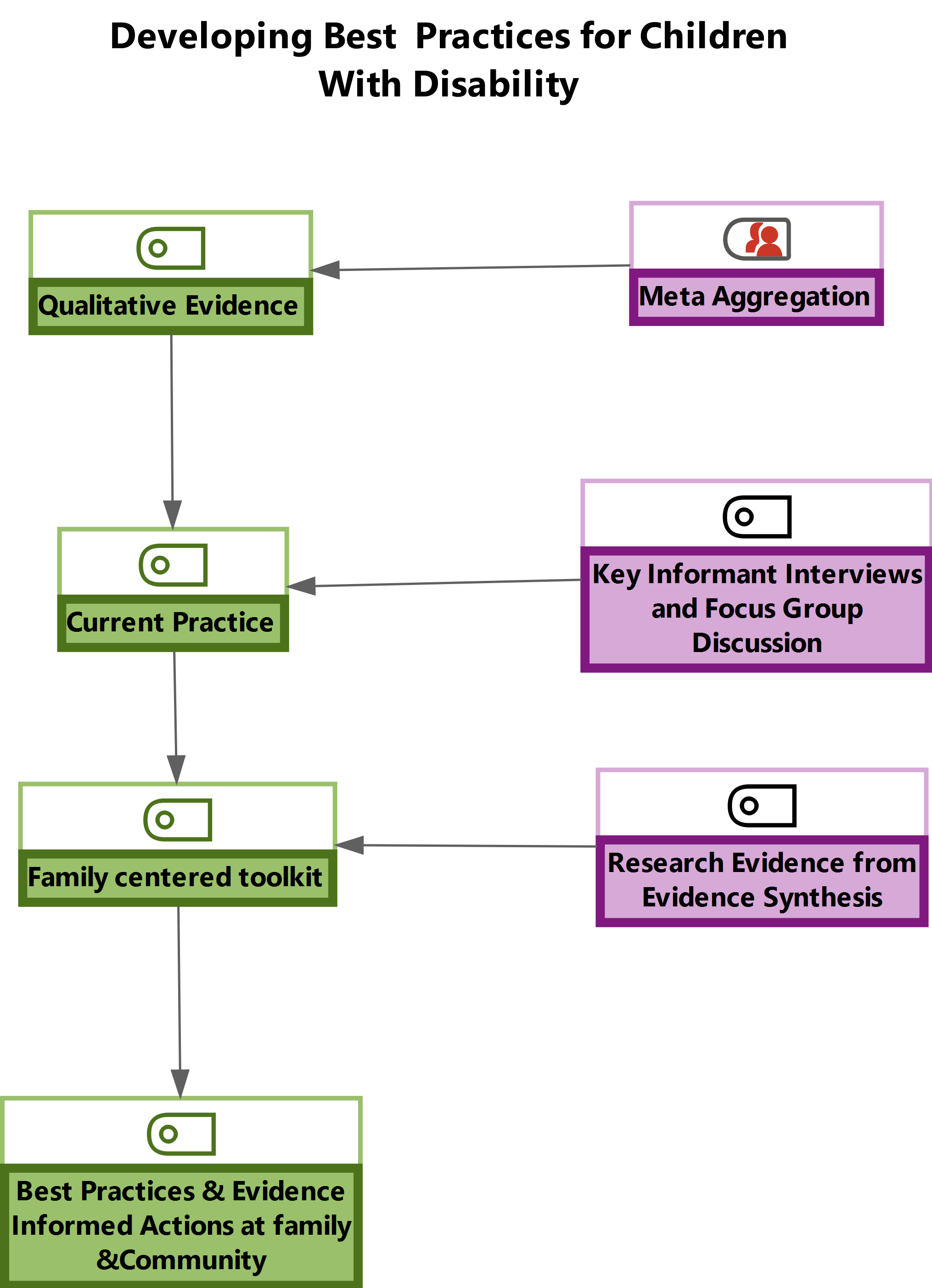
In this first episode of the disability blog series, we narrate how using evidence recommendations can improve the livelihoods of children with disabilities (CWDs). We used a rigorous and systematic approach consisting of the development of a PICO question, searching the evidence, synthesizing the evidence and using the evidence recommendations to inform families and communities.
Evidence implementation projects targeting the rights and needs of persons with disabilities (PWD) in low and middle-income countries (LMIC) have not been reported in the past to the best of our knowledge. This, therefore, implies PWD in LMIC will be left behind the evidence-based practice train. The twenty-first century experimenting society has seen a wave of innovation in the evidence revolution from the Sustainable Development Goals (SDG) agenda to the evidence portals (White 2019), our project is one of such projects that seek to bring evidence not just to practitioners and policymakers but also into the households and communities where literacy rates are very low.
In our family-centered evidence implementation project for CWDs, we successfully brought research evidence of what works into the households and communities where CWDs lived, promoting more effective interventions that contributed to health, education, livelihood, social wellbeing, and empowerment while reducing stigma and promoting rights. This has a strong implication for the SDGs as it is an evidence portal.
The first step of our family-centered implementation project was a stakeholder session. We provided training to CHWs on to ensure the inclusion of all relevant actors. Then we did a formative study using MAXQDA (VERBI Software 2020) to further inform the design of the intervention and identify current practices within households and communities with CWDs. In other to get the best available research evidence, we developed a PICO, searched the evidence, summarized the evidence and translated the evidence into a family-centered toolkit which was then used by CHWs during household visits. The family-centered toolkit basically assesses household practices and scores them against best how to use the toolkit and training to families on how to use best practices to promote rights and address the needs of CWD. Families meeting best practice cutoffs received incentives to be used for income-generating activities.
Our PICO question was “effective interventions to promote rights and address needs of CWD aged 2-17years within households and communities in LMIC” (Population: CWD aged 2-17 years living in Bamenda, Intervention: interventions to promote rights and needs of CWD, Comparator: current practices, Outcome: improved livelihoods.). We carried out a rigorous search from the evidence ecosystem databases and collaborations including Joanna Briggs, AEN, Campbell collaborations, Cochrane to inform our intervention. We found 2,124 studies after searching for different databases. 150 studies were eligible. These included 1 National Policy (Cameroun 2010) which informed us about the law protecting the rights of PWD in Cameroon and enable us to be under legal backing for our evidence implementation project. Six (6) guidelines; including one family-based guideline which provided evidence-based actions for families (Cockburn, et al. 2013), and five (5) WHO CBR guidelines for health, education, social wellbeing empowerment and livelihoods (WHO 2010). The process was also informed by the UN Convention for the rights of PWD and the matrix of inclusion of disability within the SDGs (International Disability Alliance 2018).
In total, thirty (30) families from the city of Bamenda in the North West Region of Cameroon have benefited from this pilot. This evidence implementation project is a promising approach for the promotion of rights and addressing the needs of CWDs. Its potential for integration into existing health, education, and local governance structures increases ownership and sustainability. Its incorporation of best available evidence ensures families and communities provide evidence-informed actions that will impact on the livelihoods of CWDs. Finally, this approach represents the potentials and contributions of the global south to the global evidence ecosystem which has been largely underestimated and provides learning possibilities for the global evidence movement (Stewart, et al. 2019).
The views expressed in published blog posts, as well as any errors or omissions, are the sole responsibility of the author/s and do not represent the views of the Africa Evidence Network, its secretariat, advisory or reference groups, or its funders; nor does it imply endorsement by the afore-mentioned parties.
References
Cameroun, L'assemblee Nationale. 2010. LOI Promotion Des Personnes Handicapées. Parliamentary proceedings, Yaounde: L'assemblee Nationale du Cameroun.
Cockburn, Lynn, Mukong Nicolas, Drusilla Njeatih, Shirin Kiani, Anjonga Emmanuel, Bangsi Augustine, and Raphaela Kianda. 2013. best practice Guidelines for Implementing Family-Centered Care for Children with Disabilities in North West Region of Cameroon. Guidelines, Toronto: Internation Centre for Disability and Rehabilitation University Toronto, Canada.
International Disability Alliance. 2018. The Rights of People with Disability and the Sustainable Development Goals. Denmark: The Danish Institute for Human Rights.
Stewart, Ruth, Harsha Dayal, Carina Van Rooyen, and Laurenz Langer. 2019. "The evidence ecosystem in South Africa: growing resilience and institutionalisation of evidence use." Palgrave Communications 5(1):1-2.
VERBI Software. 2020. "MAXQDA 2020 Computer Software." Berlin: VERBI Software.
White, Howard. 2019. "The twenty-first-century experimenting society: the four waves of the evidence revolution. ." Palgrave Communications. 5(1):47.
WHO. 2010. Community-Based Rehabilitation: CBR Guidelines. Guidelines, Geneva: World Health Organisation.